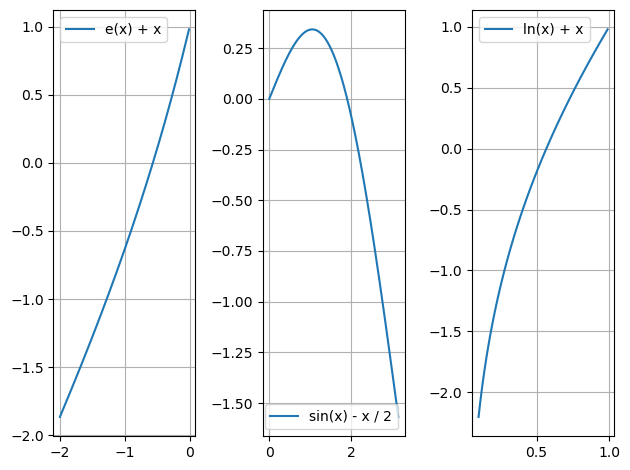Exemple d’implémentation
Contents
La page ci-présente existe en version notebook téléchargeable grâce au bouton  (choisir le format
(choisir le format .ipynb). On rappelle qu’il faut ensuite l’enregistrer dans un répertoire adéquat sur votre ordinateur (capa_num par exemple dans votre répertoire personnel) puis lancer Jupyter Notebook depuis Anaconda pour accéder au notebook, le modifier et exécutez les cellules de code adéquates.
2.5. Exemple d’implémentation#
2.5.1. Implémentation#
On propose ici des exemples d’implétentation de la méthode dichotomie.
import numpy as np
import matplotlib.pyplot as plt
# Implementation avec une boucle while
def dicho_while(f:callable, a0:float, b0:float, prec:float) -> float:
# On vérifier quand même que a0 et b0 ne sont pas les racines
if f(a0) == 0:
return a0
elif f(b0) == 0:
return b0
# Initialisation
a = a0
b = b0
n = 0 # OPTIONNEL : Compte des iterations
while np.abs(b - a) > prec:
n = n + 1 # OPTIONNEL : Compte des iterations
c = (a + b) / 2 # milieu
if f(c) == 0: # c est la racine
a, b = c, c # intervale reduit a [c,c]
elif f(c) * f(b) < 0:
a, b = c, b
else:
a, b = a, c
c = (a + b) / 2
print("Nombre d iterations : {}".format(n)) # OPTIONNEL : Compte des iterations
return c
# Implementation recursive
def dicho_recursif(f:callable, a0:float, b0:float, prec:float) -> float:
# On vérifier quand même que a0 et b0 ne sont pas les racines
if f(a0) == 0:
return a0
elif f(b0) == 0:
return b0
elif (b0 -a0) < prec:
return (a0 + b0) / 2
else:
c = (a0 + b0) / 2
if f(c) == 0:
return c
elif f(c) * f(b0) < 0:
return dicho_recursif(f, c, b0, prec)
else:
return dicho_recursif(f, a0, c, prec)
2.5.2. Utilisation#
On reprend les fonctions:
\(f(x) = \exp(x) + x\)
\(g(x) = \sin (x) - x / 2\) avec \(x > 0\) à \(10^{-12}\) près.
\(h(x) = \ln (x) + x\) à \(10^{-12}\) près.
from scipy.optimize import bisect
def f(x):
return np.exp(x) + x
def g(x):
return np.sin(x) - x/2
def h(x):
return np.log(x) + x
"""Etude graphique"""
xf = np.arange(-2, 0, 1e-2)
xg = np.arange(0, np.pi, 1e-2)
xh = np.arange(0.1, 1, 1e-2)
fig, ax = plt.subplots(1, 3)
ax[0].plot(xf, f(xf), label="e(x) + x")
ax[1].plot(xg, g(xg), label="sin(x) - x / 2")
ax[2].plot(xh, h(xh), label="ln(x) + x")
ax[0].legend()
ax[1].legend()
ax[2].legend()
ax[0].grid()
ax[1].grid()
ax[2].grid()
fig.tight_layout()
plt.show()

xf1 = dicho_while(f, -2, 0, 1e-12)
xf2 = dicho_recursif(f, -2, 0, 1e-12)
xf3 = bisect(f, -2, 0)
xg1 = dicho_while(g, 0.1, np.pi, 1e-12)
xg2 = dicho_recursif(g, 0.1, np.pi, 1e-12)
xg3 = bisect(g, 0.1, np.pi)
xh1 = dicho_while(h, 0.1, 1, 1e-12)
xh2 = dicho_recursif(h, 0.1, 1, 1e-12)
xh3 = bisect(h, 0.1, 1)
print("Racine de f : {}".format([xf1, xf2, xf3]))
print("Racine de g : {}".format([xg1, xg2, xg3]))
print("Racine de h : {}".format([xh1, xh2, xh3]))
Nombre d iterations : 41
Nombre d iterations : 42
Nombre d iterations : 40
Racine de f : [-0.5671432904096037, -0.5671432904096037, -0.5671432904109679]
Racine de g : [1.8954942670342385, 1.8954942670342385, 1.8954942670332011]
Racine de h : [0.5671432904096492, 0.5671432904096492, 0.5671432904100584]
_Note : on remarquera que les valeurs sont à peu près égales à \(10^{-12}\) près mais pas rigoureusement car le test d’arrêt dans bisect est un peu plus complexe que la simple largeur de l’intervale.

